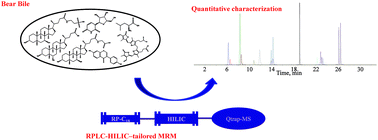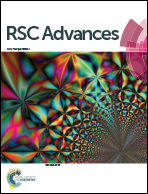Polarity-extended quantitative analysis of bear bile and its analogues using serially coupled reversed phase-hydrophilic interaction liquid chromatography-tailored multiple reaction monitoring†
Abstract
The medicinal values of bear bile are believed to rely on both hydrophilic and hydrophobic components regardless of their abundant or minor distributions. However, there is usually a technical bottleneck to simultaneously monitor components regardless of polarity and concentration due to the retention threshold of single column liquid chromatography (LC) as well as the relatively narrow linear dynamic range of tandem mass spectrometry (MS/MS). A new integrated method was developed and demonstrated to be reliable via diverse validation assays towards simultaneous determination of four nucleosides together with ten bile acids in bear bile (Chinese name: Xiongdan) as well as its analogues, although these compounds-of-interest spanned not only a large polarity range but also a great content scale. Improvements were made in both LC and MS/MS domains. In the LC domain, reversed phase LC and hydrophilic interaction liquid chromatography were coupled in series (RPLC-HILIC) to afford satisfactory chromatographic behaviors for bile acids along with nucleosides. In the MS domain, to ensure the locations of all abundant bile acids, such as TUDCA, TCA, GHDCA, CA, UDCA, HDCA, GDCA, CDCA, and DCA, in their linear dynamic ranges, response tailoring was carried out through the employment of inferior collision energies in multiple reaction monitoring (MRM) mode. The validated approach was then successfully applied for quantitative characterization of bear bile and some other medicinal bile samples. Significant differences occurred between bear bile and its analogues originating from other species as well as among bear bile samples from different manufacturers. The distributions of TUDCA, GUDCA, UDCA and CDCA, particularly TUDCA, might enable reflection of, to some extent, the quality of bear bile. Consequently, RPLC-HILIC-tailored MRM provides a qualified tool for simultaneous determination of multiple components with large polarity and content spans in bear bile as well as other bile-derived medicines.



 Please wait while we load your content...
Please wait while we load your content...